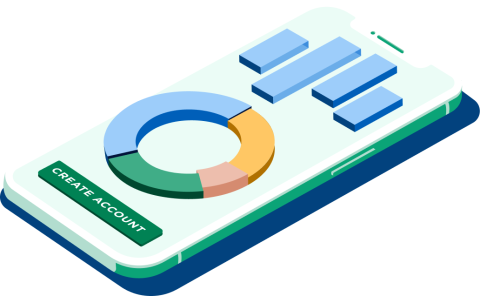How to Buy Tether (USDT)

Many or all of the products featured here are from our partners who compensate us. This influences which products we write about and where and how the product appears on a page. However, this does not influence our evaluations. Our opinions are our own. Here is a list of our partners and here's how we make money.
The investing information provided on this page is for educational purposes only. NerdWallet, Inc. does not offer advisory or brokerage services, nor does it recommend or advise investors to buy or sell particular stocks, securities or other investments.
Tether’s flagship cryptocurrency, USDT, is supposed to be pegged to the U.S. dollar, meaning that each USDT token should maintain a corresponding value of $1. Since Tether is pegged to a traditional fiat currency, it tends to behave as such, and its value rarely fluctuates. If you’re searching for a cryptocurrency with big growth potential, Tether probably isn’t for you. But some investors may like it as an easier way to move in and out of other crypto positions.
NerdWallet rating 4.9 /5 | NerdWallet rating 5.0 /5 | NerdWallet rating 4.1 /5 |
Fees $0 per online equity trade | Fees $0 per trade | Fees $0 per trade |
Account minimum $0 | Account minimum $0 | Account minimum $0 |
Promotion None no promotion available at this time | Promotion None no promotion available at this time | Promotion Get up to $700 when you open and fund a J.P. Morgan Self-Directed Investing account with qualifying new money. |
How to buy Tether
In order to buy Tether, you’ll need to follow four steps:
1. Decide whether to invest in Tether
Many crypto investors hold USDT for its price stability and liquidity, as each token promises to be redeemable for cash on a 1-to-1 basis. Investors may shift value to USDT in an effort to reduce risk they might be exposed to with other cryptocurrencies in their portfolio.
Exchanging crypto for traditional currencies like the U.S. dollar can incur transaction fees, and trade executions are often delayed. Instead, some investors choose to convert to USDT because it can reduce transaction costs and increase the speed of trade execution. It's also possible to earn interest on USDT holdings through a passive-but-not-without-its-risks process called staking.
The idea of a stable cryptocurrency that can always be redeemed for an equivalent dollar value is an attractive proposition for investors, as evidenced by the some 70 billion USDT tokens in circulation. But while Tether has been less volatile than traditional cryptocurrencies, in May 2022, the token's value briefly dipped to 95 cents, affected by a wider crypto collapse and reflecting investors' concerns about how readily their holdings could be redeemed. Tether's price soon recovered, but many are calling for more transparency about its reserves.
» Learn more: What is Tether?
2. Find a place to buy Tether
As the most widely circulated stablecoin in the world, Tether is available on several different platforms. USDT tokens can be found on most of the major cryptocurrency exchanges, over-the-counter, or OTC, desks and wallets. While there are a variety of cryptocurrency exchanges to choose from, they can be broken down into two categories:
Centralized exchanges act as a third party and provide supervision over all transactions on the exchange, instilling confidence that there is no foul play. Centralized exchanges are more straightforward and user-friendly, so they’re a good place to start for investors who are new to crypto. On the downside, they typically charge a higher fee for buying, selling or converting cryptocurrencies. And, considering the sheer volume of transactions taking place, centralized exchanges are commonly targeted by hackers.
Decentralized exchanges aim to cut out the intermediary through peer-to-peer exchanges of crypto. Since decentralized transactions on blockchain are not filtered through one entity, they’re not as likely to fall victim to a cyberattack. Cutting out third-party oversight also means fewer fees per transaction. But in the absence of rules and regulations, users have little protection if a transaction goes awry. Decentralized exchanges are not easily accessible and can be difficult to use if you don’t have much technical knowledge about the crypto market, so they’re best suited for investors with more experience.
3. Decide how to pay for Tether
Once you’re up and running on an exchange, there are two ways you can purchase Tether:
Cash: Simply deposit cash into your new account and place an order to purchase USDT. For security purposes, many exchanges require first-time users to go through verification procedures before funding their account. Once your account is verified, most exchanges will accept deposits via debit card, ACH or wire transfers from a bank account. (There are a few that will allow you to fund your account with a credit card, but doing so can be extremely risky.)
Cryptocurrency: Investors who already own cryptocurrencies can transfer digital assets to an exchange account where Tether is available. Once the account is funded, investors can choose to exchange their existing crypto holdings for USDT.
4. Purchase and store your Tether
Once you've funded your account with cash or cryptocurrency, you can begin placing trades on the exchange. In order to purchase Tether, simply log into your account and place an order to buy (cash) or exchange other digital assets for USDT tokens.
After you've become the proud owner of some USDT, there is still work to be done. You have to decide where to store your digital assets, and you have a couple of different options:
The exchange where you bought Tether likely will let you keep the tokens in your account. This is the most straightforward option for investors who are new to cryptocurrency, but it does involve some risks. The biggest is from hackers. Many centralized exchanges have taken measures to improve cybersecurity, but there’s always a chance one might break through the barriers that are in place. Furthermore, when you store digital assets at an exchange, you do not have access to the private numerical codes — also called keys — that give you full control of your assets. If you are willing to trust a third party, or simply don’t want the responsibility of keeping track of your key, this might be the best option for you, but it will leave you exposed in the event of a security breach.
A crypto wallet can be a more secure way to store your crypto but also one that requires more responsibility on your part. Storing your assets in a digital wallet requires a numerical key for proof of ownership and transaction verification. If you ever lose that key, you’ve effectively lost your assets, as there is no way for you to prove ownership.
» Learn more: Best crypto wallets
There are two categories of crypto wallets to choose from:
Hot wallets stay connected to the internet, which is convenient because it makes it easier for you to move tokens in and out of your wallet for transactions. However, it also exposes you to potential cyberattacks.
Cold wallets do not connect to the internet, meaning that you need to physically possess some sort of storage device for your keys. Cold wallets greatly reduce the threat of a security breach, but might be inconvenient for investors who may want to move digital assets in and out of storage frequently.
» Need more detail? Read our full guide to how to buy cryptocurrency

On a similar note...






